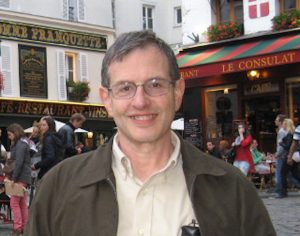Charles Rosenblatt
Ohio Eminent Scholar and Professor of Physics Emeritus
Contact
rosenblatt@case.edu
216.368.4125 (office) | 216.802.8026 (mobile)
Rockefeller Building 105C
Other Information
Degree: S.B., Massachusetts Institute of Technology (1974) Ph.D., Harvard University (1978)
About
Concentrations
Condensed Matter Experiment; Liquid Crystals and Complex Fluids
Research Interests
Liquid crystals exhibit beautiful optical textures: stars, curves, splotches, and zig-zags, all in a palette of colors rivaling the most ostentatious paintings of modern art. On closer and more scientific inspection one finds that liquid crystals are generally composed of rod-shaped molecules, which exhibit an intermediate degree of order between solid and liquid. For example, in the nematic phase the elongated molecules are orientationally ordered along a particular axis, with no long-range positional order. Since the molecules are also optically anisotropic, the polarization state of light may be altered as it passes through the liquid crystal, facilitating the brilliant display of colors. At lower temperatures partial positional order may set in, such that the molecules behave like a liquid in two dimensions, and are nearly solid-like in the third direction. This smectic phase has more than a dozen variations, each with its own characteristic symmetry.
One of my central interests has been the experimental study of phase transitions from one liquid crystalline state to another. The goal of this work is to elucidate the fundamental character of these transitions, and their relationships to other phase changes in nature. I also have spent many years studying the behavior of liquid crystals at a solid interface, and even controlling the surface on nanoscopic length scales to force various behaviors in the adjacent liquid crystal. Can we see analogies between the interface and the behavior in other systems, such as superconductors? Topological defects – this is where the “order” of the system becomes ill-defined at a point, line, or plane – and symmetry play important roles throughout nature, and much of my recent effort has been aimed and creating topological defects in liquid crystals and examining their behavior in external magnetic and electric fields. And if “mirror symmetry” no longer exists, as occurs in a helical system such as DNA and many liquid crystalline molecules, what new phenomena appear?
My scientific program also involves controlling the gravitational forces on ordinary fluids by applying an upward magnetic force. For all practical purposes, the fluid becomes weightless, allowing us to study a variety of phenomena. For example, a fluid that is tethered to two solid supports is known as a liquid bridge. Real-life examples include the fluid in the lungs, oil in porous rock, and water that wets a fabric. By studying these fluids in a quasi-zero-gravity environment, one learns about fluid stability, surface tension, and dynamics. Because the magnet force is controllable with time, we have oscillated the effective gravitational field. By doing so, we have examined the collapse of a cylindrical liquid bridge when gravity is suddenly turned on. Another research topic involves the Rayleigh-Taylor instability, which occurs when one places a dense fluid on top of a lighter fluid. Under ordinary gravity this arrangement is unstable, but one can stabilize this configuration by use of magnetic levitation of the (magnetic) heavier fluid. On turning off the field, an instability develops, and the heavier fluid falls to the bottom in a very complex manner. This phenomenon occurs in exploding supernovae and in inertial confinement in fusion processes for purposes of energy generation, which we simulate in our lab!
Over the years, my work has been funded by the National Science Foundation (continuously for 36 years), NASA, the Department of Energy, the Petroleum Research Fund, the Israel Science Foundation, the French Ministère de l’Europe et des Affaires étrangères, and the State of Ohio.
Selected Publications, until retirement in 2023 (of 220 total)
“Creating arbitrary arrays of two-dimensional topological defects”, B.S. Murray, R.A. Pelcovits, and C. Rosenblatt, Phys. Rev. E 90, 052501 (2014)
“Nodal analysis of nonlinear behavior of the instability at a fluid interface”, M.-C. Renoult, C. Rosenblatt, and P. Carlès, Phys. Rev. Lett. 114, 114503 (2015)
“Chiral oily streaks in a smectic-A liquid crystal”, I.R. Nemitz, A.J. Ferris, E. Lacaze, and C. Rosenblatt, Soft Matter 12, 6662 (2016)
“Interface Coupling and Growth Rate Measurements in Multi-layer Rayleigh-Taylor instabilities”, R. Adkins, E.M. Shelton, M.-C. Renoult, P. Carlès, and C. Rosenblatt, Phys. Rev. Fluids 2, 062001 (R) (2017)
“Chiral organosilica particles and their use as inducers of conformational deracemization of liquid crystal phases”, Orit Cohen, Andrew J. Ferris, Raymond Adkins, Robert P. Lemieux, David Avnir, Dmitry Gelman, and Charles Rosenblatt, Chem. Phys. Lett. 696, 112 (2018)
“Electric field-driven reconfigurable multistable topological defect patterns”, Saša Harkai, Bryce S. Murray, Charles Rosenblatt, and Samo Kralj, Phys. Rev. Research 2, 013176 (2020)
“Electric field-induced crossover from 3D to 2D topological defects in a nematic liquid crystal: Experimental verification”, Andrew J. Ferris, Sajedeh Afghah, Robin L.B. Selinger, Jonathan V. Selinger, and Charles Rosenblatt, Soft Matter 16, 642 (2020)
“Transition from Escaped to Decomposated Nematic Defects, and vice versa”, A.L. Susser, S. Harkai, S. Kralj, and C. Rosenblatt, Soft Matter 16, 4814 (2020)
“Anchoring-mediated spontaneous topography in thin nematic liquid crystal films”, A.J. Ferris, C. Rosenblatt, and T.J. Atherton, Phys. Rev. Lett., 126, 057803 (2021)
“Co-Revolving Topological Defects in a Nematic Liquid Crystal”, A.L. Susser, S. Kralj, and C. Rosenblatt, Soft Matter, 17, 9616 (2021)
“Energetics of topographically designed Smectic-A oily streaks”, A. Missaoui, A.L. Susser, H. Aharoni, and C. Rosenblatt, Soft Matter, 19, 3733 (2023)

